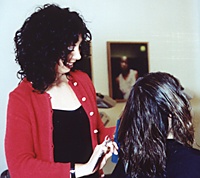
 |
|
|
Please write: dan@dancooper.tv
Return to Page One
Register here to receive Fashion Finds
email updates!

212.604.9668

 Sherwin Jones is an expert colorist. Born in Chicago, he
worked for 6 years at the Vidal Sassoon in his hometown, and then moved to New York, where
he quickly became head of the color and perm department of the downtown Manhattan salon.
He spent 10 years in all with Sassoon. Sherwin's ability to create a totally natural,
soft, beautiful color palette for clients is phenomenal. By the same token, if you want a
fabulous, fun and brilliant color -- you can have that too. Funny, with a great joy for
life, Sherwin puts clients immediately at ease.
Sherwin Jones is an expert colorist. Born in Chicago, he
worked for 6 years at the Vidal Sassoon in his hometown, and then moved to New York, where
he quickly became head of the color and perm department of the downtown Manhattan salon.
He spent 10 years in all with Sassoon. Sherwin's ability to create a totally natural,
soft, beautiful color palette for clients is phenomenal. By the same token, if you want a
fabulous, fun and brilliant color -- you can have that too. Funny, with a great joy for
life, Sherwin puts clients immediately at ease. 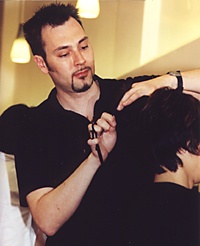 Alex Sansone is a wonderful stylist. Originally from
Buffalo, NY, he worked for Sassoon for 11 years. He trained and took his license in
Buffalo, and then went to a Sassoon training course in Toronto. There he became very
excited by Sassoon's innovative cutting techniques and styles, and decided to join in.
Alex worked at the downtown Sassoon salon, too, where he was a very popular and in demand
stylist. Tranquil, kind, and reassuring, Alex has the ability to make a person feel
completely comfortable. He has a wonderful, subtle sense of humor. In early 1995, Alex
began to get the urge to go out on his own, to break away from the large corporate
rigidity, and create a more comfortable environment.
Alex Sansone is a wonderful stylist. Originally from
Buffalo, NY, he worked for Sassoon for 11 years. He trained and took his license in
Buffalo, and then went to a Sassoon training course in Toronto. There he became very
excited by Sassoon's innovative cutting techniques and styles, and decided to join in.
Alex worked at the downtown Sassoon salon, too, where he was a very popular and in demand
stylist. Tranquil, kind, and reassuring, Alex has the ability to make a person feel
completely comfortable. He has a wonderful, subtle sense of humor. In early 1995, Alex
began to get the urge to go out on his own, to break away from the large corporate
rigidity, and create a more comfortable environment. 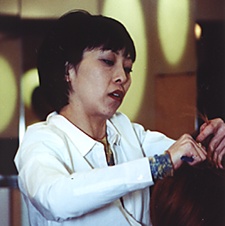 Penny Wang is a terrific stylist also. Born in Taiwan,
educated in Japan and then in San Francisco, Penny's concentration was sculpture and the
fine arts (she made an incredible Santa Claus sculpture for the salon last Christmas). She
was drawn to hair cutting, finding it the closest thing to sculpture; both are about shape
and form. Precision haircutting is her metier. She worked at Sassoon for 10 years, and was
the assistant art director before she left. Penny is energetic, outgoing, charming, and
has one of the best laughs you've ever heard. Like Alex and Sherwin, she too was looking
to open a salon that was more free and flexible, where expression and creativity could be
achieved without inhibition. Collectively, they have more than achieved their dream.
Penny Wang is a terrific stylist also. Born in Taiwan,
educated in Japan and then in San Francisco, Penny's concentration was sculpture and the
fine arts (she made an incredible Santa Claus sculpture for the salon last Christmas). She
was drawn to hair cutting, finding it the closest thing to sculpture; both are about shape
and form. Precision haircutting is her metier. She worked at Sassoon for 10 years, and was
the assistant art director before she left. Penny is energetic, outgoing, charming, and
has one of the best laughs you've ever heard. Like Alex and Sherwin, she too was looking
to open a salon that was more free and flexible, where expression and creativity could be
achieved without inhibition. Collectively, they have more than achieved their dream.
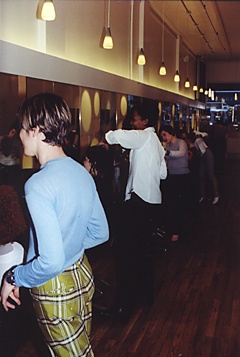 FF: I have a lot of
readers here in New York, but I also have a lot of readers from all over the country and
all over the world. And some people live in places where they don’t have access to a
salon like Aerea. What advice do you have for people who don’t necessarily have
access to a salon of the quality of yours? What should they look for in a salon, or if
they do it themselves, if they home color, what advice would you give them?
FF: I have a lot of
readers here in New York, but I also have a lot of readers from all over the country and
all over the world. And some people live in places where they don’t have access to a
salon like Aerea. What advice do you have for people who don’t necessarily have
access to a salon of the quality of yours? What should they look for in a salon, or if
they do it themselves, if they home color, what advice would you give them?
Alex Sansone: One thing I can say is, in searching
for a salon or for a hairdresser, generally what’s best to do is find someone who has
a similar hair texture to yours, and a cut that you like. And then that would be the place
to go. What happens sometimes is people will say, "Ooh, I really like your
haircut", but if their hair is straight and the other person’s hair is curly,
some hairdressers, especially in more suburban places, may not be well versed in all
different hair textures, so find someone with a similar texture to yours, and also that
you like their haircut.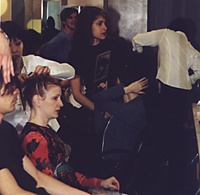
FF: Okay.
Sherwin Jones: Also, fashion magazines -- find
pictures of anything that you’re interested in. And stylists in salons -- I think
they’re always willing to do consultations. It’s always best to speak about a
particular cut or style, as opposed to just going in and having it done. That way you can
at least have a little bit of trust and get familiar with the location, familiar with the
salon and look around to see work that they’ve done.
As a colorist, I’d never recommend that anybody does any hair coloring at home. It’s as simple as that. There are a lot of things professionally done, from health hazards to the actual results and textures and qualities of hair that people can’t really achieve themselves.
FF: Because usually it’s too harsh would you say?
Sherwin Jones: Chemically, you know, it’s different from painting, and in getting a color on a canvas so to speak.
FF: Right.
Sherwin Jones: Because you’re trying to change one texture to achieve a different color. So when you’re painting on the canvas, you use blue and you expect to see blue. If you use a blue hair color on someone who has black hair, you won’t see anything at all. So the expectation of coloring your hair yourself, you know you really can’t be too sure you’re going to get what you’re looking for.
And then once again there are some health hazards that could be an issue with the person if they’re coloring their hair themselves. A lot of people can be allergic to certain things. And that’s quite a common thing to happen.
FF: And what should people do to take care of their hair, whether they color it, they go in religiously every six weeks to have it cut, or whatever? What is the best way to maintain healthy hair, no matter what you do with it?
Alex Sansone: I think one of the biggest mistakes
is that people shampoo their hair too frequently, on a daily basis, when really every
second or third day is enough. It allows some of the natural oils to build up in the hair.
So I think generally people tend to shampoo their hair too frequently. Also, testing out
different products to see what works well on their hair texture -- you may have to shop
around for a few different types of product. You don’t need to necessarily spend a
lot of money on products, but you really do need to try out different combinations to find
out what works for you.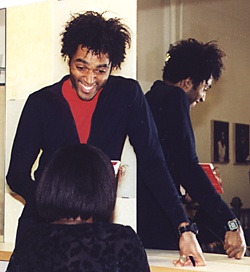
The one thing I just wanted to add to the idea that Sherwin mentioned, of consulting in salons -- sometimes you need to shop around, go to a few different salons to consult with people, see who you feel comfortable with, and does the salon environment feel comfortable to you. So don’t tag along with the idea of seeing someone whose haircut and texture you like. Visit other, different locations or different salons to find one where you feel comfortable.
FF: Definitely, definitely -- not just jump in to the first place you walk into.
Alex Sansone: Right. Educate yourself and shop around.
Penny Wang: About taking care of your hair for better conditioning, what happens is, a lot of people have curly hair, and they insist on blow drying it straight. And that’s definitely the most damaging, the most common thing that people do to damage their own hair. That point, no matter what kind of conditioner you use, it’s not going to repair the day to day blow drying and pulling and stuff like that.
FF: Right, right.
Penny Wang: And also, I will definitely go along
with the previous question. I definitely recommend people to go to the best salon that
they feel comfortable in, to really analyze what type of texture hair they have, and what
is the best way to style and care on a daily basis. On the color part also -- you know, if
you go to a great salon, and get a great hairstyle, and the colorists do a style and color
for you, then you can go back to your own neighborhood to find a salon that can follow up
for you. And that will be another suggestion. Because I do have a lot of clients who
don’t live in the city, and that’s kind of what they do.